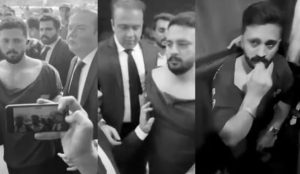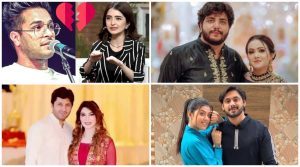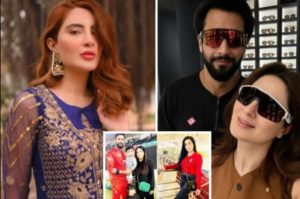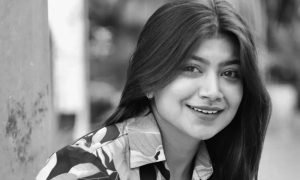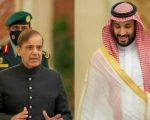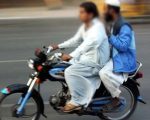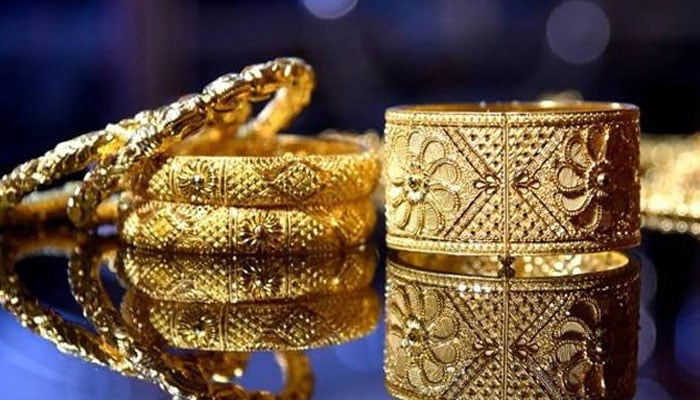It was around 11 am on a sweltering hot and stuffy afternoon in my Gulshan-e-Jinnah 2 story flat No. 11-B in Islamabad. My wife was glued to the TV expectantly, all ears to the media circus being unfolded for the 2 o clock judgment on the Panama Case – the “Mother of all decisions”, “the decision to be remembered for centuries”. Load-shedding at its peak and nothing much to do except waiting for the Panama verdict which seemed to me like “Waiting for Godot”.
Just a week before driving around the Jinnah Super I had come across the flaps on display amounting to the “art exhibition” next door at the PNCA National Gallery. I had been to PNCA a number of times before to view its permanent display of Sadequains and off and on theatrical performances. But there was nothing extraordinary ever to write home about.
11.30 am. As my wife and I entered the main exhibition hall on a spontaneous romantic sojourn, we were still trying to adjust to the relative cool darkness inside in comparison to the dazzling brightness and the baking heat outdoors. It felt like walking through paradise of a sublime miracle of the artistic expression. There couldn’t have been a better expression of what had happened to us in the last 70 years in the land of the pure and how we have all contributed to it and been a something so big in such a large measure.
As we entered, a jet red quilt titled “comforter” startled us with its bloody shine. It was blood, blood everywhere: red, faded, coalesced, as if splattered on the walls, on our faces and our clothes.
“Khoon keh dhabbay dhullain gai kitni barsaaton keh baad.”
And then a mountain of garbage of crumpled paper all splashed with red blood stains rising to a height of a small hillock and spilling to the side galleries from the open doors. Unmistakable, unavoidable and unrelenting – like an eye sore pricking at our conscience, ever-present. Maybe each crumpled sheet symbolized every man, woman and child butchered in our war against ourselves?
Aisa Khalid’s miniatures were distinctive and showed the esoteric meanings of I, you & we: being alone and together, individual and the collective. The wash paper, the intricate designs embroidered, thread by thread, pattern upon pattern like a weaver’s hand embroidered piece: greens, red upon gold or black backgrounds. Stark. Crying in silence.
“Woh harf e tanha jissay tamana e wasl e maana, keh hum hain iss sar zameen peh jaisay woh harf e tanha, jo aarzo e wisaal e maani mein ji raha, jo harf o maani ki yaqq dilli ko taras gaya hou.“



And then right in the middle of the hall, a display to decipher the last 40 years of mayhem: a green, red and khaaki patterned wrap all around the central pillar. An artist’s SALUTE.
Imran Qureshi’s blood soaked path led us to the other gallery, still following us through an open door, the blood-stained garbage and litter blocking our steps, right there at our feet.
“Hum jo tareek raahon mein maaray gaye, teray hontoun keh phooloun ki chaahat mein hum.“
Right in front, a long narrow glass covered casket with wavy and folded white spread sheet of a shroud titled “Siraat e Mustaqeem.” An exhibit to end all exhibits, interpret it in any way you like, 70 long years it had taken to come to the right path.
“Garri hain kitni saleebain meray dareechay mein, har ek apnay khudaawand keh khoon ka rangg liyay.”
Back again to the main hall. In a calligraphic pattern two perfect cubes all black and one golden side facing each other. Maybe us and our alter egos facing each other. Or maybe the ultimate: HIMSELF finally being revealed to its essence the KAABA. My mind was fully agitated as I wandered from one piece to another. From “deep within the heart” to something breaking, making sense, some meaning, finally an interpretation of our woes. My wife had to drag me out. I barely read out Ayesha Khalid 1972, Faisalabad; Imran Qureshi, Hyderabad, 1972.
As I climbed the stairs back and forth to find the installation in the open air theatre I found the writeup by Imran Qureshi on a wall depicting something to the effect of ‘coming home.’ However, to my best efforts, I couldn’t find the artwork that the curator had told us about, a contribution by students from Peshawar and Quetta. I happened to casually walk myself up to the verandah in the scorching heat beating so strongly on my uncovered head that it felt like a heat stroke might finally get the best of me. I looked upon the horizon and before me were the landmarks of the Islamic Republic, the Secretairat, Establishment Division, Presidency, the Parliament, Supreme Court, PM Secretariat – all arranged in a perfect line, all glistening white. And then I dared to look down, and my heart stopped a beat.
Below, the whole amphitheater, the stairs, and the stage were splattered with blood-red paint. Blood everywhere, not shiny or bright like the ‘comforter’, but dull as if something in the past, not fresh but mistakenly there, permanent. And behind the stage, fresh green grass within which were sprouting small colored tiny flowers as if:
“Sab kahaan kuch lala o gul mein numayaan hou gayein..“
I wanted to shout at the top of my voice towards the Parliament, Supreme Court, Secretariat.. but it was so damn hot my voice choked. The unbearable lightness of being. I rushed back down to my wife and straight shot out of the venue. I “survived”.
It was now 2 o clock. The Panama Verdict was about to be announced. And I hoped the verdict will be:
“And this 5 member bench finds all the 200 million people of the Islamic Republic of Pakistan guilty, and convicts them to 22 years of much more vigorous imprisonment.”
If only the honorable bench had taken the time out to visit the exhibition just next doors.



